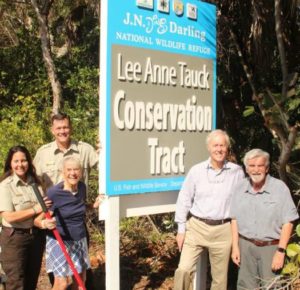The Florida Fish and Wildlife Conservation Commission has awarded the “Ding” Darling Wildlife Society-Friends of the Refuge $75,000. The refuge will use the money for invasive plant management at the upland portion of the new 68-acre Lee Anne Tauck Conservation Tract.
In partnership with Lee County Conservation 20/20, DDWS worked to raise $9.5 million to acquire the tract, the largest remaining parcel of undeveloped land on Sanibel Island, in 2019. The 68-acre tract had been deeded for up to 29 luxury homes. As an important corridor between the refuge and Sanibel-Captiva Conservation Foundation lands, the property originally known as Wulfert Bayous was deemed critical to the refuge’s conservation mission. The refuge now manages the 68 acres as part of the “Ding” Darling complex.
Last year, the National Fish & Wildlife Foundation awarded $5.3 million to the refuge to further plans for restoring the tract’s wetlands. DDWS partnered on the application for that Gulf Environmental Benefit Fund grant aimed at restoring bird populations affected by the catastrophic BP Deepwater Horizon Oil Spill in 2010.
“This new funding will apply to the tract’s acreage not considered wetlands,” said DDWS executive director Birgie Miller. “Whereas the BP grant will help rehabilitate habitat for refuge shorebirds, the FWC funding will help the refuge protect gopher tortoises, bobcats and other upland species.”
DDWS previously had applied unsuccessfully for the funding, but with the assistance of Cathy Olson, formerly of Lee County Conservation 20/20 and now part of Pennoni Associates, Inc., the funding application resubmission was successful.
Olson is helping refuge staff with the requirement to complete the invasive species removal project within a year’s time, as required by the FWC. Currently, the team is seeking bids for the work.
“A huge thank-you to Cathy for her help with this crucial project in ridding the Lee Anne Tauck Conservation Tract of nonnative vegetation that hinders the survival of native species,” said Miller. “We rely on partners in the public and private sector to fulfill the refuge conservation mission, and this is one more example of how beneficial collaboration can be.”

